This year has been an especially challenging year. Hopefully one of the good things to come of it is a more widespread understanding of how important science and accurate science communication are and how it’s becoming increasingly important to be able to spot bad and fake science online.
If your new year’s resolution includes learning even more about how to spot pseudoscience and increasing your science literacy, I highly recommend these two free online courses: This science literacy course is provided by the University of Alberta, and this Truth Behind Food Headlines course is from the University of Reading. I’ve completed both courses and highly recommend them.
In the spirit of moving forward into the new year and helping to stop the spread of misinformation, here are 10 food and nutrition misconceptions to leave behind this new year:

1. ‘Avoid food products that contain more than five ingredients’
What? Why? Who came up with this, and why do I still hear it being given as nutrition advice? I’m pretty sure the origin of this one came from none other than Michael Pollan circa 2008 when he was promoting his new book. The only thing I think of when I hear people give this advice is, “Wow, your food must be really bland!”
There’s no scientific basis to this rule and certainly no need to continue perpetuating it. Leave it behind and for your tastebuds’ sake — season your food!
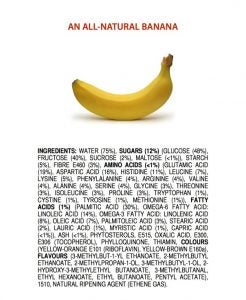
2. ‘If You Can’t Say It, Don’t Eat It’
Ah yes, more Michael Pollan certified nonsense. Not only is there no scientific basis for this one either, but it’s just incredibly ableist too. Whether you can pronounce an ingredient or not has absolutely no bearing on its safety or nutritional content.
I’m sure most people wouldn’t be able to pronounce the chemical names of many of the compounds that make up fruits and vegetables, but that doesn’t mean you shouldn’t eat them. This arbitrary food rule should have been left in the dust a long time ago.
View this post on Instagram
3. ‘It’s Banned in Europe!’
This is one of the most prevalent misconceptions that I’ve addressed over the past year. I’ve made several videos on it, which you can find in my “Banned in Europe?” series on my Instagram page. In many cases, these “banned in Europe” claims are not actually even true. It is a bit confusing, because food additives are labeled differently in the EU versus the U.S., for example, FD&C Yellow 6 is labeled as E110 in the EU.
In some cases, yes, it’s true that certain ingredients are approved in the U.S. and banned in the EU, but the opposite is true as well. There are actually more approved food colors in the EU than in the U.S., but whether an ingredient is banned in a specific country tells you nothing about it’s safety. In some cases, ingredient bans are based on political or other reasons not having to do with safety at all. Sometimes an ingredient may just not be approved in specific countries because there simply isn’t a need for it. Availability and cost of ingredients as well as consumer preferences can play a role in differing formulations too.
Just because the same product may have a slightly different formulation from country to country (which is quite common) or a longer ingredient list doesn’t mean that something sinister is going on or that one is safer or inferior to the other.
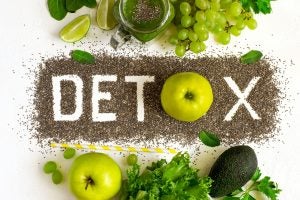
4. Detox Diets
Get ready for the diet and detox frenzy come the new year, but please pay no mind to it. Chances are you don’t have a toxic amount of any substance in your body as you’d be in the hospital if that were the case. So, claims that “toxins” are building up in the body so that they are at a toxic dose are pretty ridiculous.
A series of chemical reactions is performed by the liver to convert toxic substances into ones that can be eliminated in bile, or the kidneys, and the kidney excretes waste products into the urine. “To argue that either organ needs a ‘cleanse’ is to demonstrate a profound ignorance of human physiology, metabolism, and toxicology.” On top of that, there is no credible evidence to demonstrate that detox products do anything at all. They have not been shown to remove “toxins” or offer any health benefits. There is also the potential for these products and specific detox diets to cause some real harm.
5. Wellness Culture and Celebrity Advice
You know, wellness culture, where everything not “natural” is deemed “toxic” and the goal is to remove these “toxins” from your life in order to look like Gwyneth Paltrow. Yeah, that’s wellness culture in a nutshell.
Here’s the issue; it’s based on nothing but the appeal to nature fallacy. Natural does not equal safer. The dose makes the poison applies to all chemicals and whether a chemical is natural or synthetic tells you precisely nothing about its safety. This is why the term “toxic chemicals” in reference to only synthetic chemicals, while “natural” ones get a pass, makes entirely no scientific sense. Some of the most toxic chemicals known are naturally occurring, and Paltrow herself promotes injecting the most toxic substance known: botulinum toxin, aka Botox, into your face. Of course, the version she promotes is “clean” though (insert eye roll here). Botox is safe, which is a great example to show that the dose makes the poison applies to everything, even the most toxic substance known!
Remember, if someone is claiming a food or ingredient is “toxic,” but they’re not providing the specific chemical, the dose and scientific evidence showing that it’s toxic to humans at that dose and exposure route, then they either have no clue what they’re talking about, are trying to deceive you and/or are trying to sell you something. What’s actually toxic is wellness culture. If you’re looking for a good new year’s resolution, I recommend cleansing your social media feed of anyone promoting this pseudoscience.
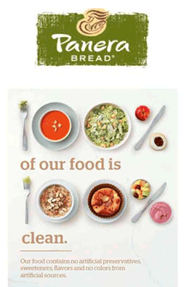
6. Clean Eating
“Clean” when it comes to food is a meaningless marketing term unless you’re literally referring to cleaning the dirt off of food. When referring to food, ingredients or eating, “clean” isn’t even defined. Companies make up their own arbitrary definitions and then market those foods as healthier and/or safer, usually with an upcharge too.
Panera is a prime example. They created their own definition of “clean food,” which, to them, means that the food doesn’t contain any ingredients on their “No-No List.” Yes, they seriously created a “No-No List” because apparently we are children who need to be told “no-no” when we eat “dirty food” with scary sounding ingredients. You know the term is meaningless when alcohol companies start marketing everything from hard liquor to wine as “clean.” Food is neither “good,” “bad,” “clean,” nor “dirty.” Food is food. Leave the food shaming behind this year.

7. GMO Fearmongering
I’ve written quite extensively about GMOs, so I’m not going to get into too much detail here, but fear of GMOs is due to a lack of understanding of what “GMO” really means. A 2019 study found extreme opponents of genetically modified foods know the least but think they know the most.
If GMOs are something you avoid due to not really understanding what it means, please take this opportunity to learn more about different genetic modification techniques and how “GMO” is simply referring to just a few of the many techniques used to genetically modify crops. The graphic below is an excellent reference as well as the accompanying article. I’ve also posted extensively about GMOs and have organized resources into an Instagram highlight here.
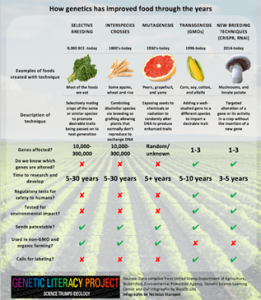
The bottom line is that GMOs are just as safe and at least as nutritious as their non-GMO courterparts, and they can benefit the farmer, environment, and consumer, but the technology used to create GMOs is just one of many tools. What we desperately need are fewer fear-based marketing labels and more scientific literacy.
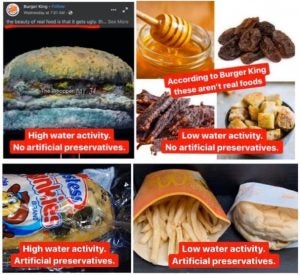
8. ‘Real’ Food Gets Moldy
I know you’ve seen this one. It’s the one where someone digs out a 10 year old fast food burger and fries from their basement that has essentially been mummified and everyone goes berserk thinking the food must be unfit for consumption if it didn’t mold. Burger King even used this misconception as an ad campaign for their “real” burgers that mold.
The proper response to this, of course, is to ask if raisins are unfit for consumption too, after all, those won’t grow mold either, but for some reason the narrative just isn’t the same for foods like dried fruits.
You see, this is due to a simple concept called water activity. Moisture migrates from areas of high water activity to areas of low water activity until equilibrium is established. So, if the water activity of the food is greater than that of the surrounding air, the moisture will migrate from the food to the air, thereby decreasing the water activity of the food. If the equilibrium water activity is lower than what is required for mold and bacterial growth and is reached before any microorganisms have had a chance to grow, then mold and bacteria simply won’t be present on the resulting dried out food.
Drying, or dehydration, has been used to preserve foods such as fruit, meat, and bread for thousands of years. Essentially, the burger and fries dried out and turned into beef jerky, two large croutons, and potato chips. Have you ever worried about opening a bag of potato chips and seeing mold? No, because, science.
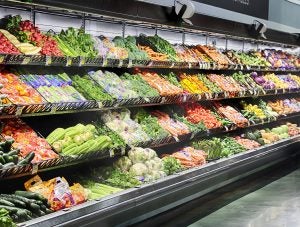
9. Demonizing Safe and Accessible Foods
Food insecurity and food deserts are real issues here in the U.S. I often see specific diets and expensive ways of eating being touted as the only way to be in good health and along the way, foods that are less expensive and more accessible get demonized. Blanket statements about “processed” food and “preservatives” being bad or unhealthy are simply just inaccurate.
Many processes and preservatives are used to make food safer, more nutritious and last longer, thereby increasing access and decreasing food waste as well as rates of foodborne illness. These are not bad things, so using “processed” or “preservatives” to imply something negative about a food is inaccurate. Cooking, canning, freezing, and pasteurization are all examples of processes that are used to make food safer and last longer. Some preservatives can add essential nutrients to the product as well. For example, ascorbic acid (Vitamin C) and tocopherols (Vitamin E) can be added as a preservative and can help to satisfy nutrient requirements.
Let’s flip the script and start talking about how great these technologies are in allowing for safer, more affordable, and more accessible food!
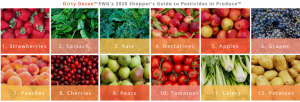
10. The Dirty Dozen
I’ve said it before and I’ll say it again, the Dirty Dozen belongs in the trash.
Despite the data consistently showing how safe our food is, the Environmental Working Group (EWG) manipulates this very data to scare consumers about perfectly safe conventional foods. They publish their list every spring and recommend that people purchase organic versions of these fruits and vegetables because they claim that they are “cleaner” and have less pesticide residue. However, what they do in their “analysis” is take the U.S. Department of Agriculture’s Pesticide Data Program findings and just count the number of pesticide residues on each type of food. That’s it. The list is made up based on the total number of different pesticides detected on each food. They completely disregard what the chemical is, at what concentration it occurs on the food, and how that compares to the crop-chemical-specific Environmental Protection Agency tolerance levels.
They also don’t ever mention that fact that organic farming uses pesticides, too, and that the organic versions of these foods will have pesticide residues as well. In addition to that, they leave out the fact that the USDA PDP is not set up to be able to detect most of the organic-approved pesticides because it would require expensive and specific assays. The PDP annual summaries consistently show that 99 percent of sampled products have residues well below EPA tolerances, which are set based on an extensive and rigorous risk assessment reflecting all the toxicological information available. The EWG then takes that data and ranks the foods based on a metric that has absolutely nothing to do with the safety of the food.
The bottom line is that our food supply is incredibly safe from a pesticide residue perspective. With only one in 10 Americans eating enough fruits and vegetables each day, we should be promoting consumption, not discouraging it. Unfortunately, the Dirty Dozen does some of the worst kind of harm. A recent study showed that fear-based messaging regarding pesticide residues resulted in low income consumers stating they were less like to purchase any produce — organic or conventional. So, I’ll say it one more time, the Dirty Dozen belongs in the trash.
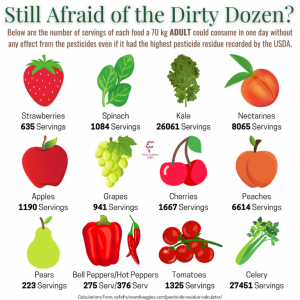
Cheers to a new year and to helping make anti-science misinformation about food a thing of the past!
Food Science Babe is the pseudonym of an agvocate and writer who focuses specifically on the science behind our food. She has a degree in chemical engineering and has worked in the food industry for more than decade, both in the conventional and in the natural/organic sectors.




